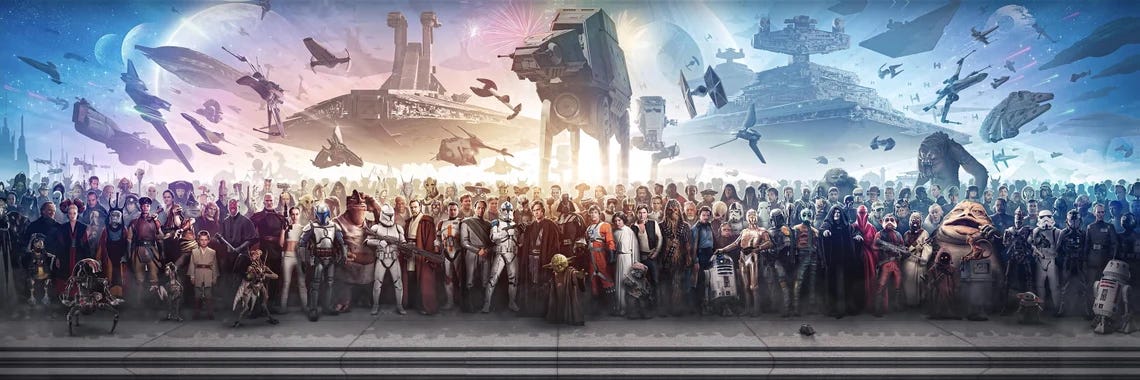
In a SubStack essay called The Rise of Worldbuilding and the Decline of Literature, G.M. Baker writes:
Every story is set in a story world. This is a necessity. The real world is too big, too messy, too full of distractions. To tell something as neat and compact as a story, an author needs a neat and compact world to set it in. In this sense, worldbuilding has always been part of storytelling. But recently, worldbuilding has emerged as an artform of its own, with an extensive network of both creators and consumers. Stories are still somewhat necessary to animate built worlds, but, as I have increasingly come to realize, they are secondary to the worldbuilding, and even objectively dull, ill-told stories can serve their intended purpose of putting the built world into motion.
Take, for example, Star Wars… The series continues to have an enormous fandom and the only way I can account for that is that they are fans of the worldbuilding rather than the storytelling. It is, to be sure, fantastic worldbuilding.
The “setting” or “story world” of Star Wars Episode IV: A New Hope is all the scenes in which the movie takes place. Parts of Tatooine, the Millennium Falcon, parts of the Death Star, parts of Yavin IV.
None of these parts (“story world”) exclude the implication of a whole (“worldbuilding”). As Baker reminds us: “A neat and compact world to set [the story] in.”
In essence, it’s the principle of Chekhov’s Gun applied to setting: Are we here for the story of Star Wars, or are we here for the geological history of Yavin IV?
How much do we truly need to know so that the setting works as a central part of the story without completely overshadowing the whole?
As worldbuilding has and continues to rise as a separate yet related endeavor altogether, it’s a question storytellers can’t ignore.
Consider this: When what we call Star Wars Episode IV: A New Hope first came out, it wasn’t called “Episode IV” or “A New Hope.” It was just called “Star Wars.”
It was only later, after George Lucas’s worldbuilding machine cranked into fifth gear, that the original Star Wars was redefined according to its broader worldbuilding context. It went from defining Star Wars was and only was to being a subset of a larger whole. That’s one of the biggest implications of worldbuilding over and above any individual setting. Like history in real life, stories in worldbuilt sagas becomes part of a larger, interconnected whole.
Think about Luke’s reference to “the Clone Wars” in episode 4. That had no concrete meaning for 1977’s audience. Before the prequels came out (late 1990s/early 2000s), the reference was a curious footnote; if you’ve only seen the original trilogy, the Clone Wars reference basically means nothing. If you’ve seen the prequels, it means something. If you’ve seen Dave Filoni’s multi-season saga, it means a whole lot.
I note all this to drive home an important point:
The essential difference between “story world” and “worldbuilding” is that “story world” is that aspect of setting needed to tell a particular story while “worldbuilding” is the broader setting, assumed but not shown, in which that “story world” exists.
Here’s an image that illustrates the point:
The distinction between “story world” and “worldbuilding” are essential for specualtive fiction authors, especially those working today who understand that, like it or not, there’s almost a presumption for contemporary writers to do something with worldbuilding, just like there’s a presumption that we’re writing a series rather than standalone stories. So…
WHAT ARE THE GOALS OF THIS SERIES ON WORLDBUILDING?
Three biggies:
To better understand the applications and limits of worldbuilding.
To explore strategies that will improve our worldbuilding.
To learn to better utilize worldbuilding alongside setting, character, plot, theme, etc., to compose better stories.
While worldbuilding in and of itself has, as Baker told us, arisen as something of its own art form in the past few years, my goal here is to ground worldbuilding within the composition of better stories.
As an author of stories, it’s not enough for me to simply enjoy the process of imagining new worlds. I world-build so my stories will be better. That’s the bullseye we’re aiming at.
Which begs a question…
WHY AM I A DECENT SOURCE ON THIS TOPIC?
First, of all the classic elements of story, “setting” was my first love. I’ve always paid close attention how environments influence people and events, whether imagined ones or real life ones.
Second, I’m a student of storytelling. I pay attention to what other writers have said about setting and worldbuilding, and because it fascinates me, I pay close attention to how it’s executed in different kinds of stories.
Third, I’ve been worldbuilding the same series since 2009, so I have almost two decades of practical experience thinking deeply about and working through this in my own writing, including the invention of one fictional language and two fictional alphabets. I’ve thought about and practiced the art of utilizing setting to tell better stories.
That’s why I’m worth listening to about this, and why I hope you’ll join me in part 2 where we’ll answer three key questions:
What is speculative fiction?
What is setting?
How can we apply setting to speculative fiction writing and tell better stories?
If you’d like to keep up with this series, why not…
That way you don’t miss a beat?
Thanks for reading, and keep your eyes peeled for EPISODE 2 coming soon!
Agree? Disagree? Something nice to say? Leave it below.
DANIEL RODRIGUES-MARTIN is the author and editor of books, articles, essays, poems, reviews, and countless rants since 2004. His debut novel, GODDESS FROM THE MACHINE, is available from most major carriers.




